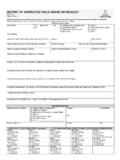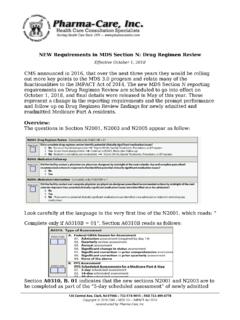Transcription of By Owen MacDonald, Group Publisher, QuantiaMD Foreword …
1 May 15, 2011 disruptive physician BehaviorBy Owen MacDonald, Group Publisher, QuantiaMDForeword by Barry Silbaugh, MD, MS, FACPE, CEO, American College of physician ExecutivesDisruptive physician Behavior1 May 15, 2011 2011, QuantiaMD . No reproduction without physician behavior is the issue that just won t go away. Despite the best efforts of many, our profession is still plagued by doctors acting in a way that is disrespectful, unprofessional, and toxic to the workplace. The topic is simply too important to ignore, and I m pleased the American College of physician Executives is working with QuantiaMD to shine new light on this controversial survey and the resulting white paper clearly illustrate how frequently these behaviors occur and how they re often tolerated in the safety-critical work of health care.
2 While a relatively small number of individuals are at the center of this dysfunction, their behavior creates a ripple effect that touches all of us: physicians, nurses, patients, and this phenomenon is an uphill battle. For many of us, this is behavior we learned from abusive instructors in medical school. The constant stress, long hours, and bureaucratic quagmires inherent in health care serve to exacerbate the situation. It s not getting any easier in this era of reform, where the rules seem to shift from day to day and the financial rewards may be silver lining is our ability to create change.
3 By bringing more attention to this issue, perhaps we can finally chase it from the shadowy, dark corners of our profession and into the light. This study is just the first step toward working together for solutions on how to report, address, and ultimately eliminate bad learned that fighting in the cockpit was stressful and contributed to catastrophes, so they changed their behaviors yes, behaviors. We can do the same. By tightening and defining expected communication behaviors among members of the health care team, we ll take a giant step toward improvement.
4 We want you to help us make disruptive behavior an artifact of the past in health OF CONTENTS Foreword ..1 Executive summary ..2 Demographics ..3 Types of disruptive behavior ..4 Organizational insights ..6 physician insights ..9 Consequences and opportunities ..12 Conclusions ..13 Methodology ..14 Barry Silbaugh, MD, MS, FACPECEO, American College of physician ExecutivesDisruptive physician Behavior2 May 15, 2011 2011, QuantiaMD . No reproduction without than 70% of physicians say that disruptive physician behavior occurs at least once a month at their organizations, and more than 10% say that such incidents occur on a daily basis, according to a new study of more than 840 physicians and physician leaders from QuantiaMD and the American College of physician Executives (ACPE).
5 (Figure 1) These findings suggest that health care organizations have an urgent need, if not obligation, to address such types of disruptive behavior physicians encountered range from profanity to refusal to follow established protocols to, though rare, outright physical assault. Seventy-seven percent of respondents said they are concerned about disruptive behavior at their organizations, and 99% believe that disruptive behavior ultimately affects patient care. (Figure 2)Such behavior can have tangible consequences 60% of physicians said their organizations have received written complaints from patients or their families, and 50% have seen patients actually change physicians or leave a practice due to such behavior .
6 Perhaps most telling is the finding that 26% of physicians admitted to engaging in disruptive behavior at one time in their career. Respondents said that the two most common contributors to those incidents were workload and learned behaviors, such as those acquired at medical school, which again suggests that organizations have an opportunity to address core causes of disruptive physicians expressed some confidence in their ability to confront disruptive behavior themselves, the majority said they wanted to learn more. Other needs included strategies for disciplining physicians for disruptive behavior , as well as improving culture and communication.
7 The results depicted in this report reflect how practicing physicians are negatively affected by disruptive physician behavior , and how such behavior can, in its worst form, trickle down to affect patient care and patient satisfaction. However, the results also speak to an opportunity for health care organizations to improve their organizational culture; to offer education and support to physicians affected by these behaviors; and to work swiftly and effectively to address disruptive behaviors when they arise, before they negatively impact patient care and patient satisfaction.
8 Executive summaryFigure 1: How often do you estimate physicians at your organization exhibit disruptive behavior ?11% Daily26% One incident per week34% One incident per month29% One incident per year or lessN = 842 Figure 2: To what extent do you believe that disruptive physician behavior affects patient care?60%0 Never Rarely Sometimes Always37%Percent of respondents53%9%1%N = 832 disruptive physician Behavior3 May 15, 2011 2011, QuantiaMD . No reproduction without respondents were a mix of physician leaders and staff physicians from a wide variety of health care settings and practice types.
9 More than 60% of survey respondents hold a leadership title at their organization, including medical director (34%), chief medical officer (12%), department chair (10%), vice president of medical affairs (4%), and president of the medical staff (3%). (Figure 3) In terms of gender, 73% of respondents were male, and 27% female. (Figure 4) A plurality of physicians came from private practices (35%), followed by hospital-based physicians (33%) and those from academic institutions (18%). (Figure 5) Respondents were nearly evenly split between urban and suburban practice settings (44% and 43% respectively), with the remainder (13%) practicing in rural settings.
10 When it came to the number of physicians on the medical staff, 45% of respondents came from practices with less than 50 physicians on staff. Practices with more than 200 physicians comprised the second largest Group , at 31% of respondents, with the remainder of physicians falling somewhere in the middle. (Figure 6)DemographicsFigure 6: Number of physicians on staff <50 51-100 101-150 151-200 200+50%0 Percent of respondents45%10%9%6%31%N = 841 Figure 3: Titles12%10%34%3%4%38%0 4 0 %Percent of respondentsChief Medical OfficerDepartment ChairMedical DirectorPresident of Medical StaffVice President of Medical AffairsPhysiciansN = 844 Figure 5: Practice types35% Private practice33% Hospital-based18% Academic/University14% OtherN = 842 Males73%Figure 4: Male vs.





